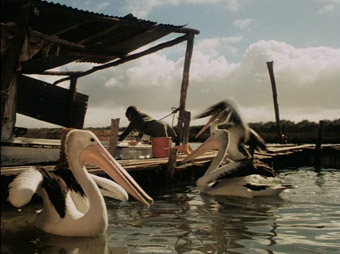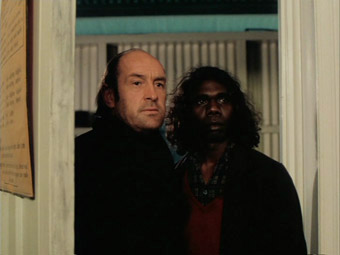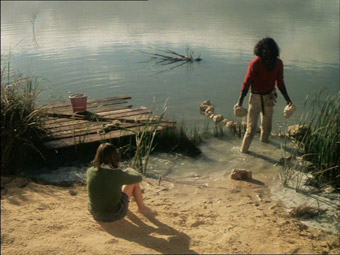| |
"When I was one-and-twenty/I heard a wise man say/
'Give crowns and pounds and guineas/But not your heart away/
Give pearls away and rubies/But keep your fancy free'/
But I was one-and-twenty/No use to talk to me." |
| |
A.E. Houseman, A Shropshire Lad |
| |
"Talk about the moon floating in the sky/Looking like a lily on a lake/
Talk about a bird learning how to fly/Making all the music he can make/
Happy talk/Keep on talking happy talk/Talk about things you'd like to do/
You got to have a dream/If you don't have a dream/
How you gonna have a dream come true?" |
| |
Rogers & Hammerstein, Happy Talk, South Pacific |
Storm Boy (1976) is an enchanting, subtly subversive coming-of-age drama set in and around the Coorong, a wetland lagoon at the mouth of the Murray River on Australia's southern seaboard. The film, adapted from Colin Thiele's much-loved children's classic, revolves around a ten-year-old boy, Mike Kingsley, brilliantly played by Greg Rowe in his first acting role. Mike lives contentedly with his Dad, 'Hideaway Tom', in a ramshackle hut on the Younghusband Peninsula, a low-lying sandbar separating the Coorong from the Southern Ocean. Mike and Tom, free spirits both, work together to generate a subsistence living from fishing; consuming little, gleaning driftwood from the beach, taking each day as it comes. They don't need much and they don't have much. They have each other though, and a local landscape of breathtaking elemental beauty.

Mike has a raft reminiscent of Huckleberry Finn's and inhabits a Boy's Own adventure playground. All he lacks is friendship. To our delight he finds it. While paddling the lagoon one day, he notices woodsmoke rising from the shore. He lands to investigate and is startled by an Aboriginal outcast, 'Fingerbone Bill', exiled from his people, the Kunai, after breaking tribal law. Fingerbone scares Mike, who scarpers, but the two meet again soon after, when, out collecting pebbles on the beach, Mike is drawn to the sound of gunfire. Fingerbone has made his way to the scene of the disturbance too and they fall in together. Fingerbone shoots at the unwelcome hunters, who flee, but not before they have killed a mother pelican. Mike and his newfound friend find three newborn, newly orphaned pelican chicks nearby and Mike adopts them.
He names them Mr Proud, Mr Ponder and Mr Percival, then lovingly feeds and rears them. We share his joy as he watches these extraordinary birds grow, and marvel with him at the wonderful sound of their gentle honking calls. When the pelicans are full-grown, though, Tom insists they be returned to the wild. Mike's sadness at this loss, which he accepts with uncomplaining maturity, turns to joy when his favourite of the three, Mr Percival, returns. A relationship of trust develops between boy and bird, one mirrored in the deepening friendship between Mike and Fingerbone and in the sense of mutual respect that grows between Fingerbone and Tom. Director Henry Safran sidesteps the dangers of a descent into mawkishness by delineating these relationships, with intelligence, subtlety and sensitivity. Those qualities are also on full display in the acting: Greg Rowe as Mike, Peter Cummins as Tom, David Gulpilil as Fingerbone, and, yes folks, 'Mr Percival – as himself', all deliver excellent, convincing performances.
There is such delicacy of feeling about this warm-hearted, heart-warming film that one is reluctant to highlight its weaknesses, but the soundtrack must not be let off the hook. Ponderous at best, schmaltzy at its worst, it often edges the film toward Disneyland and its brash artificiality diminishes our enjoyment of the natural world recorded by the camera. Its insistent pounding drowns out sounds we'd rather hear: the whisper of wind and waves, the chirruping of lapwing and plover, the honk of the pelican and the call of the curlew. We crave the silence that the images might speak. We yearn to escape harsh noise into that quiet sense of tranquility we feel when the camera sweeps the coastline like the wind and tracks the flight of the pelicans. Fortunately, the story is told with such sincerity and care, and the film is so well executed otherwise, that we are just about able to blank the soundtrack out.

The plot synopsis above might suggest that Storm Boy is a sweet, slight film. Actually, the film reclaims the word 'sweet' from sarcastic cynics and contains hidden depths. While the film can be viewed simply as a charming children's story, it is more, much more than that. Thematically rich, it confronts rather than evades uncomfortable truths. If the cinematography is occasionally too picture-postcard-pretty for its own good, the broader picture is painted with light and shade. Storm Boy presents the antipodean culture of mateship and the fair go in its purest form, but it also shows that life contains both sunlight and storm. The father-son relationship, for instance, is shown to be more complex than immediately meets the eye and narrative tension is created from a compelling clash of cultures and civilisations. The problems of the outside world invade Tom and Mike's idyllic retreat in several forms: the murderous hunters who kill Mr Percival's mother; a party of businessmen on a fishing trip, the kind who know the price of everything but the value of nothing and who trail trouble and pollution in their wake; a gang of 'drunken hooligans' who attack the shack; and, most significantly, a local schoolteacher determined to remedy Mike's lack of formal education, thereby endangering the delicate eco-system of the Kingsley's unorthodox homelife.
Another significant invasion is repelled as the very start of the film. While combing the beach for firewood Mike finds a radio. Bemused, he dusts it down and takes it home. Storm Boy is light on dialogue but Mike's discovery of the radio leads to one of the keynote exchanges of the film. Tom, a taciturn but thoughtful man, distrusts the dishonest wider world and his own honest feelings in equal measure; he is in flight from both. He orders Mike to bin the radio and all it represents. After Mike innocently queries the decision later, Tom gently calls him over for a fireside chat:
"It's time we had a talk son. I want you to grow up honest. Now lying's about as low as a man can get. It's a coward's way of getting what he's after. And you've got to learn that you can't have everything you want. The radio will tell you you need this and that and a thousand other things. You want more and more, so you end up chasing a lot of rubbish. You got to trust me son."
It is a speech that echoes Walter Brennan's 'Heelots' speech in Frank Capra's Meet Joe Doe ("I don't read no papers and I don't listen to radios either. I know the world's been shaved by a drunken barber."). For Tom, like Brennan's Connell, the battle lines are drawn: it is 'us against them', freedom against constraint, the attempt to live a life of honest integrity against the prevalent lies of the wider world. In this respect and others Storm Boy has much in common with other films of the Australian New Wave of the 1970s and it can proudly take its place beside more celebrated, more obviously 'serious' films of that movement.

Often likened, lazily, to Ken Loach's Kes (ok, the film features a boy and bird), Storm Boy might more productively be compared to Nicholas Roeg's 1971 classic Walkabout, which prefigured the thematic concerns of the Australian Film Renaissance that followed on its heels. On many levels Storm Boy feels like a less dark and polemically aggressive, more charming and optimistic re-working of Walkabout. It is no mere accident of cinema that Storm Boy is less despairing too, because, as we shall see, much had changed for the better in Australian society between the making of the two films. It was certainly no accident that David Gulpilil plays the Aboriginal role in both films: Henry Safran cast him on the strength of his appearance in Walkabout and he performs a tribal dance in Storm Boy similar to the one he delivers to Jenny Agutter in Roeg's film. Gulpilil might be described as the Sydney Poitier of Australian cinema. Just as Poitier was a positive role model for African Americans, rising to fame as Americans were getting to grips with racism through the Civil Rights Movement, so Gulpilil did for Aboriginal Australians, arriving as he did at the moment white Australians were, for the first time, wrestling with their country's maltreatment of the continent's indigenous peoples and at a time of intense political change in Australia.
If much had changed for Black Australians between the making of Walkabout and Storm Boy, much had also changed for the Australian film industry and for women between the 'Ocker' comedies of the early 70s and Gillian Armstrong's My Brilliant Career (1979). Those and other significant changes in Australian society and film culture arose principally from one seismic political event: Labor's electoral victory of 1972, which lead to the installation of Gough Whitlam as Prime Minister and the country's first left-wing, reformist government in 23 years. In the three years before Whitlam's unceremonious, undemocratic removal from office by the Queen's representative in Australia, the Governor General ("A Queen is quaint. A Governor General Ain't"), the Whitlam government transformed Australia. Enacting a record number of bills in parliament, the Whitlam administration implemented equal pay for women and increased pensions, ended support for Apartheid-era South Africa and withdrew troops from Vietnam, established a legal aid system and a national health service, replaced 'God Save the Queen' with 'Advance Australia Fair' as the national anthem, ended the racist White Australia policy and introduced land rights for Aboriginal Australians, and abolished the death penalty, conscription and university tuition fees. The Whitlam government also rescued the moribund Australian film industry by creating film funding bodies and by founding the National Film, Television and Radio School in 1973.

The Australian New Wave, like all such film movements, took shape when it did and as it did in specific, local circumstances. It is unthinkable that the Australian New Wave, Storm Boy or even Julia Gillard would have appeared had Gough Whitlam not changed Australia for (the) good. Of course, all images have ideologies stuck to them. Directors have political perspectives as surely as their audiences, and all participants in the production and reception of films bring their own preconceptions with them. Storm Boy, though, was particularly marked by the politics of its time. The energetic optimism and national self-confidence of the Whitlam years, encapsulated in Labor's 1972 'It's Time' campaign, are clearly present in the film. The making of Storm Boy coincided with a time in which Australians were facing down their traditional 'cultural cringe', when they were feeling sufficiently confident both to open up to indigenous peoples and to accept responsibility for the wrongs done to those peoples by Australian racism and consumer capitalism.
As New Times film critic A.O. Scott suggested in his review of Walkabout, the films of the Australian New Wave remind us that "the price of living in the modern world is a feeling that we've fallen out of touch with the natural world. We long for a lost innocence . . . that still exerts a significant hold on our imaginations." He continues by noting that the New Wave, "condemned the brutality of Western civilisation while celebrating the nobility and vitality of native people." That is as true of Storm Boy as it is of Peter Weir's Picnic at Hanging Rock (1975) or Fred Schepisi's The Chant of Jimmy Goldsmith (1978). It is even true of Yoram Gross's Dot and the Kangaroo (1977), a Disneyesque children's cartoon. As the Oxford Companion to Australian Film says, "The overlapping stories of alienation, marginalisation and loss that connect Storm Boy, Fingerbone Bill and the pelicans . . . are powerful allegories for potential relations between Blacks and Whites." It is worth noting that the Coorong was an area of huge historical significance for Aboriginal culture as well of being of vital importance to numerous species of birds.

At the risk of 'overburdening' the film, I'd like to close by mining one final level of meaning in the film, its insistence on environmental responsibility. In common with many other films of the New Wave, Storm Boy shows a deep, prescient respect for the Australian landscape and the environment. It also proposes a positive model for sustainable natural living that amounts to a recapitulation of the old adage, "the more you consume, the less you live." Tom's observation that "wild things should be free" could as easily be applied to Storm Boy's human as well as to its pelican cast. Australia produces more pollution per person than almost any other nation but, in defiance of that later norm, Fingerbone, Mike and Tom leave behind negligible carbon footprints. Meanwhile, tragically, the environment we see in Storm Boy has since been despoiled by drought and industrial overconsumption of freshwater in the Murray/Darling basin. The water in the Coorong now contains six times more salt than seawater and the abundant vivacity of its local eco-systems have been replaced by a new Dead Sea. The thriving wetlands, the willowy seagrass, the sandpipers, the fish, the pelicans, all are gone. It is almost as if this magical film, in delivering its warnings to the present, had also predicted the future.
The loss of the pelicans is particularly poignant. Pelicans have betokened blameless purity and solidarity down centuries; their habit of nestling their beaks in their chests gave birth to the myth that mother pelicans draw their own blood to feed their young in time of need. In Lal Waterson's powerful English folk song The Flight of the Pelican their disappearance represents the departure of decency and the destruction of community: "We who dreamed young and were silent this autumn/In the last throes of an upstart old crow/Saw the flight of the pelican." Storm Boy speaks of a comparable Australian loss of innocence and presents an alternative worldview in which friendship, decency and sanity prevail. Let cynics sneer, this soulful film silences their bunkum. It reawakens dormant dreams and leaves us feeling saner, cleaner, more cheerful and alive. It speaks to our best selves and to the child within us all, while challenging us to maintain our rage and our enthusiasm for change. That's a good go for a 'children's film'.
There have been some pretty unkind words said about the transfer on Crabtree Films' DVD, and certainly the screen grabs here do not accurately reflect how it looks on a decently calibrated screen. Sourced from a print held by the National Film and Television Archive or Australia, the image is far from pristine, with an earthy tint to the colour palette, and contrast that provides solid black levels but that sucks in a fair amount of shadow detail, including, when the light is not good, the detail on David Gulpilil's face. Some flickering and the odd brief blemish remain, and there some very noticeable compression artefacts on cloudy skies. The sharpness and level of detail varies, but at its best is very good, usually on daylight exteriors when the sun hits the characters, Tom's boat or his ramshackle home, and some effort has clearly gone into cleaning the print up, despite the dust spots that remain. Just occasionally this give the image an almost luminous quality that is very attractive.

Another bone of contention has been the 4:3 framing, the accusation being that it is cropped from the original ratio of 1.85:1. But is it? Just because 1.85:1 is listed on IMDb as the original aspect ratio that doesn't automatically make it so, and clips I've been able to track down elsewhere suggest that we're looking at an open matte transfer of a film whose original projected aspect ratio was closer to 1.66:1. Characters certainly never feel cramped within frame nor the action cropped, and the occasional surplus of headroom does suggest a slightly tighter vertical framing was intended, although this is balanced by shots that would lose out to such cropping. Not a perfect transfer then, but a better one than some have suggested.
The Dolby mono 2.0 soundtrack is largely clean of noise or damage, and although a little tonally narrow, the dialogue is always clear and there is no sign of distortion or background hiss.
Not a thing, unfortunately.
Storm Boy is a brilliantly executed, deeply affecting adaptation of a popular children's novel. The film focuses on Mike, a 10-year-old boy, and his formative relationships with 'Mr Percival', the pelican he adopts, 'Fingerbone Bill', an Aboriginal outcast, and his father, 'Hideaway Tom'. By turns uplifting and melancholic, Storm Boy portrays the confusion and innocence of infancy with unmatched sincerity and sensitivity. The boy's unsteady steps towards maturity are paralleled by the film's questing search for answers. Impatient of intolerance and avarice, Storm Boy is a thought-provoking fable on the imbalances in our lives and world. It insists, with gentle force, that the refusal of constraints has its own rewards and that true friendship teaches great lessons. Storm Boy has long been cherished in Australia but deserves wider appreciation. Warmly recommended.
|